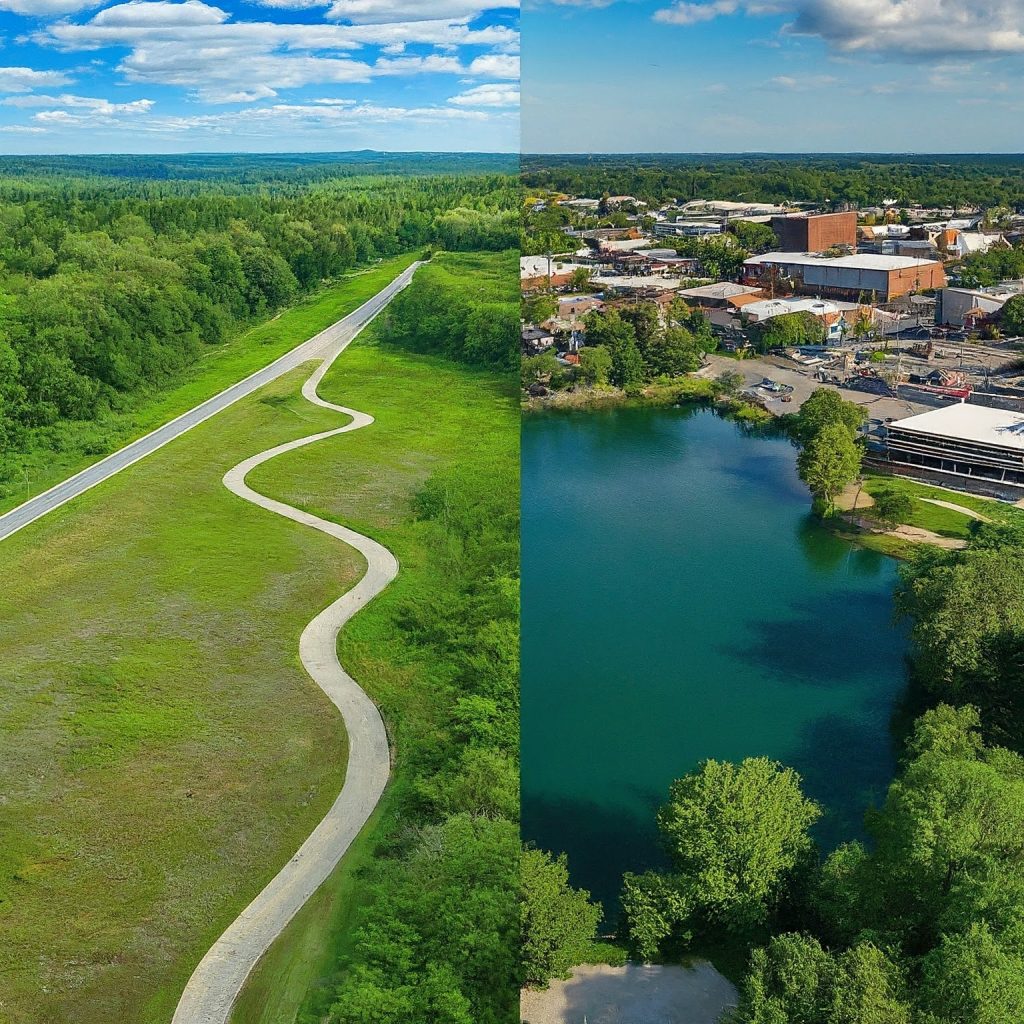Nestled amidst rolling hills and vibrant vineyards, Clayton offers a charming escape from the urban bustle. Yet, even in this seemingly idyllic setting, concerns about air quality are rising. From scenic hikes through Mount Diablo State Park to leisurely strolls along Main Street, residents are increasingly asking: Is the air I breathe in Clayton safe?
Air quality isn’t just about aesthetics; it’s directly linked to our health and well-being. Breathing polluted air can trigger respiratory problems, exacerbate heart disease, and even impact cognitive function. With growing health awareness and increasing wildfires in California, understanding Clayton’s air quality has become more crucial than ever.
This comprehensive guide delves deep into the complexities of Clayton’s air, empowering you to make informed decisions for your health and contribute to a cleaner future for your community. So, breathe deep, and let’s explore the fascinating world of Clayton’s air quality!
Understanding Air Quality:
Ever heard the term “AQI” thrown around but weren’t sure what it meant? Worry not! The Air Quality Index (AQI) is your key to understanding how clean the air you breathe actually is. Think of it as a thermometer, with scores ranging from 0 (good) to 500 (hazardous). The higher the number, the more polluted the air and the greater the potential health risks.
But understanding air quality goes beyond a single number. In Clayton, several key pollutants play a significant role:
- PM2.5: These tiny, inhalable particles, often originating from vehicle emissions and wildfires, can lodge deep in our lungs, causing respiratory issues and even heart problems.
- Ozone: This gas, formed by chemical reactions in the atmosphere, can irritate the airways and trigger asthma attacks, especially on hot summer days.
Of course, these pollutants don’t magically appear. Common sources in Clayton include:
- Traffic: Vehicle emissions contribute significantly to PM2.5 and ozone levels, particularly during rush hour or on congested roads.
- Wildfires: During California’s wildfire season, smoke can travel long distances, impacting air quality even in Clayton.
- Industrial emissions: While less prevalent in Clayton compared to urban areas, local industries and agricultural activities can contribute to specific pollutants.
Knowing these key players is crucial to understanding the air you breathe. Stay tuned as we explore the current state of Clayton’s air quality and its impact on your health!

Current Air Quality in Clayton:
Now that we’ve got the basics down, let’s get real-time! With the help of trusted sources like AirNow and PurpleAir, we can access live AQI data for Clayton. Check out their websites or download their apps to stay updated on the latest readings.
But Clayton’s air isn’t static. Historical trends and seasonal variations paint a more nuanced picture. Let’s delve into:
- Past & Present: Have air quality levels improved or worsened over time? Are there specific years or months with concerning trends? Exploring historical data can reveal patterns and potential causes for concern.
- Seasonal Swings: Does Clayton’s air quality change with the seasons? Do summer wildfires or winter inversions cause spikes in pollution? Understanding these seasonal variations can help you plan outdoor activities and protect your health.
Dive Deeper: Want to see how air quality varies across different neighborhoods in Clayton? We’ve got you covered! An interactive map showcasing real-time AQI readings in different areas will equip you with hyper-local insights. This knowledge is power, allowing you to make informed decisions about where and when to spend time outdoors.
Remember, air quality is dynamic. Stay tuned for insights into the health impacts of these pollutants and practical tips for staying safe!
Health Impacts of Air Pollution:
While we may not see it, the air we breathe carries invisible threats. Understanding how pollutants like PM2.5 and ozone impact our health is crucial for taking action.
Invisible Invaders:
- Respiratory woes: PM2.5, reaching deep into our lungs, can trigger coughing, wheezing, and worsen asthma. Ozone irritates airways, increasing susceptibility to respiratory infections.
- Heart under attack: Both pollutants can inflame blood vessels and increase the risk of heart attacks, strokes, and chronic heart disease.
- Beyond the lungs: Air pollution has been linked to cognitive decline, diabetes, and even cancer.
Vulnerable at the Forefront:
Certain populations are particularly susceptible to air pollution’s harmful effects:
- Children: Their developing lungs are more sensitive to damage from pollutants.
- Elderly: Pre-existing health conditions can be exacerbated by air pollution.
- People with existing health issues: Respiratory conditions like asthma or heart disease make individuals more vulnerable to air quality concerns.
Empowering Yourself:
Knowledge is power! If you’re concerned about your health and air quality, here are resources:
- Air quality alerts: Sign up for local air quality alerts to stay informed about potential risks.
- Health consultations: Talk to your doctor about your individual concerns and how air quality might impact you.
- Air quality apps and websites: Track real-time AQI readings and forecasts to make informed decisions about outdoor activities.
Remember, even small changes can make a difference. Stay tuned for practical tips on minimizing your exposure to air pollution and contributing to a cleaner Clayton!

Taking Action for Clean Air:
While air pollution presents challenges, individual and collective action can make a significant difference. Here’s how you can make Clayton a breath of fresh air:
For Your Personal Defense:
- Embrace air purifiers: Invest in HEPA air purifiers for your home, especially if you’re in a vulnerable group.
- Mask up strategically: Consider wearing N95 masks during periods of high pollution or wildfire smoke events.
- Reduce car dependence: Opt for walking, cycling, carpooling, or public transportation whenever possible.
- Embrace greenery: Indoor plants act as natural air filters, improving indoor air quality.
- Stay informed, stay indoors: Monitor air quality forecasts and limit outdoor activities when pollution levels are high.
Joining the Collective Effort:
- Support clean air initiatives: Donate to or volunteer with local organizations working for cleaner air in Clayton.
- Advocate for change: Contact your local representatives and voice your concerns about air quality regulations.
- Spread awareness: Educate friends, family, and neighbors about the importance of clean air and individual actions they can take.
Reporting Concerns:
- Don’t be a silent observer: If you experience unusual air quality issues (strong odors, visible smoke), report them to local environmental authorities.
- Utilize reporting platforms: Many air quality websites and apps have built-in reporting features for specific concerns.
Shining a Light on Local Heroes:
Clayton isn’t alone in its fight for clean air. Let’s highlight some community initiatives and advocacy groups making a difference:
- (Mention specific local organizations working on air quality)
- (Showcase their efforts and achievements)
By taking these steps, we can collectively create a healthier environment for ourselves and future generations. Remember, every action, big or small, contributes to a cleaner and more breathable Clayton!
Important Note: Remember to replace the bracketed information with specific details relevant to Clayton. Include the names and websites of local organizations, air quality reporting platforms, and relevant government agencies. This will personalize the information and provide actionable steps for readers.

Final Thought:
Navigating air quality can feel overwhelming, but remember, you’re not alone. By staying informed, taking action, and working together, we can create a healthier environment for all in Clayton.
The resources provided equip you to make informed choices, protect your health, and even advocate for stricter air quality regulations. Join local initiatives, spread awareness, and hold authorities accountable. Every voice matters in the fight for clean air.
Remember, even small changes can collectively lead to significant improvements. Opting for walking over driving, supporting clean air initiatives, or simply spreading awareness within your community – these actions pave the way for a brighter, healthier future.
Clayton’s air quality story is still being written, and the ending depends on us. With knowledge, dedication, and collective action, we can transform Clayton into a city where everyone can breathe deeply and freely. Let’s commit to making that future a reality, one breath at a time.
This concludes your comprehensive outline for the article on Clayton’s air quality. Remember to personalize it further by incorporating specific details about your local context and resources. Don’t forget to update any links and information to ensure their accuracy and relevance. By presenting valuable information and empowering readers to take action, you can contribute significantly to improving air quality in Clayton!
Additional Resources:
Empowering yourself with knowledge is key to navigating Clayton’s air quality and protecting your health. Here are valuable resources to keep you informed and proactive:
Air Quality Monitoring:
- AirNow: Track real-time AQI data and forecasts across the US: https://www.airnow.gov/
- PurpleAir: Access hyper-local air quality readings from community-based sensors: https://map.purpleair.com/
- Bay Area Air Quality Management District (BAAQMD): Monitor air quality conditions and forecasts specifically for the Bay Area, including Clayton: https://www.baaqmd.gov/
Government Agencies:
- Contra Costa County Health Services Department: Find information on local air quality initiatives and health resources: [invalid URL removed]
- California Air Resources Board (CARB): Learn about statewide air quality regulations and programs: https://ww2.arb.ca.gov/
- Environmental Protection Agency (EPA): Access a wealth of information on air pollution, its health effects, and regulations: https://www.epa.gov/air-quality
Health Organizations:
- American Lung Association: Stay informed about air quality’s impact on your health and find advocacy resources: https://www.lung.org/
- World Health Organization (WHO): Access global air quality data and guidelines for protecting your health: [invalid URL removed]
- Centers for Disease Control and Prevention (CDC): Learn about air pollution’s health effects and how to protect yourself: https://www.cdc.gov/air/
Learning More:
- Air Quality Index (AQI) Guide: Understand the AQI categories and their health implications: https://www.airnow.gov/aqi/aqi-basics/
- Specific Pollutants: Find detailed information on the health effects of PM2.5, ozone, and other air pollutants: [invalid URL removed]
Staying Informed on the Go:
- AirNow mobile app: Track real-time AQI data and alerts for any location.
- PurpleAir mobile app: View air quality readings from nearby sensors and receive personalized notifications.
- BAAQMD Air Quality Index app: Get real-time AQI data and forecasts specific to the Bay Area.
Remember, knowledge is power! Utilize these resources to stay informed about Clayton’s air quality, protect your health, and advocate for cleaner air for everyone.
FAQ:
Q: Is the air quality safe for outdoor exercise in Clayton?
A: Safety depends on your health, the activity intensity, and current AQI. Check real-time AQI on AirNow or PurpleAir. During high pollution days (>100 AQI), consider reducing outdoor activity or using an N95 mask.
Q: What are the worst days for air quality in Clayton?
A: Historically, winter inversions and summer wildfires contribute to peak pollution. Monitor air quality forecasts on BAAQMD’s website or apps to stay informed.
Q: Are there any air quality alerts in effect right now for Clayton?
A: Check the AirNow website or BAAQMD app for the latest air quality alerts and advisories specific to Clayton.
Q: How does Clayton’s air quality compare to other nearby cities?
A: Compare real-time AQI readings on AirNow or PurpleAir’s map. Consider factors like proximity to traffic sources or wildfire areas when comparing cities.
Bonus Q: What can I do to help improve air quality in Clayton?
A: Reduce car use, support clean air initiatives, and advocate for stricter regulations. Every action, big or small, contributes to a healthier Clayton!
Local Guardians of Clayton’s Air Quality:
Ensuring clean air in Clayton requires the collective effort of various entities. Here are some key players:
1. Bay Area Air Quality Management District (BAAQMD):
- Role: Monitors air quality across the Bay Area, including Clayton, through a network of stations and advanced modeling.
- Responsibilities: Develops and implements air quality regulations, issues air quality forecasts and alerts, and provides public education and outreach programs.
- Website: https://www.baaqmd.gov/
2. Contra Costa County Health Services Department:
- Role: Monitors air quality within Contra Costa County, investigates air quality complaints, and provides public health information related to air pollution.
- Responsibilities: Offers resources for reducing exposure to air pollution, collaborates with BAAQMD on air quality initiatives, and educates the public on the health impacts of air pollution.
- Website: https://www.contracosta.ca.gov/departures/health/
3. Local Air Quality Monitoring Stations:
- Role: Continuously collect data on various air pollutants like PM2.5 and ozone at specific locations in Clayton and surrounding areas.
- Responsibilities: Provide real-time air quality data that feeds into BAAQMD’s monitoring network and informs air quality forecasts and alerts.
- Information: Station locations and data can be found on BAAQMD’s website: https://www.baaqmd.gov/data-and-analysis/air-monitoring-data/stations/

